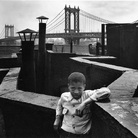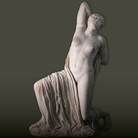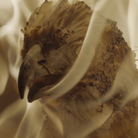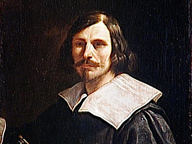Il Palazzo Enciclopedico

Logo 55. Esposizione Internazionale d’Arte, 2013, Venezia
Dal 1 June 2013 al 24 November 2013
Venezia
Luogo: Giardini della Biennale
Indirizzo: Viale dei Giardini Pubblici (Giardini Biennale), 30122, Venezia
Orari: 10-18 Chiuso il lunedì
Curatori: Massimiliano Gioni
Telefono per informazioni: 041 5218 828
E-Mail info: promozione@labiennale.org
Sito ufficiale: http://www.labiennale.org
Sarà aperta al pubblico fino a domenica 24 novembre 2013 ai Giardini e all’Arsenale la 55. Esposizione Internazionale d’Arte dal titolo Il Palazzo Enciclopedico, curata da Massimiliano Gioni e organizzata dalla Biennale di Venezia presieduta da Paolo Baratta. La vernice avrà luogo nei giorni 29, 30 e 31 maggio 2013. La cerimonia di premiazione e di inaugurazione si svolgerà sabato 1° giugno.
La Mostra sarà affiancata da 88 Partecipazioni nazionali negli storici Padiglioni ai Giardini, all’Arsenale e nel centro storico di Venezia. Sono 10 i paesi presenti per la prima volta: Angola, Bahamas, Regno del Bahrain, Costa d’Avorio, Repubblica del Kosovo, Kuwait, Maldive, Paraguay, Tuvalu e Santa Sede.
Novità assoluta è la partecipazione della Santa Sede con una mostra allestita nelle Sale d’Armi, in quegli spazi che la Biennale sta restaurando per essere destinati a padiglioni durevoli.
Il Padiglione Italia in Arsenale, organizzato dal Ministero per i Beni e le Attività Culturali con la PaBAAC - Direzione Generale per il paesaggio, le belle arti, l’architettura e l’arte contemporanee - è curato quest’anno da Bartolomeo Pietromarchi.
La Mostra Il Palazzo Enciclopedico formerà un unico percorso espositivo che si articolerà dal Padiglione Centrale (Giardini) all’Arsenale, con opere che spaziano dall’inizio del secolo scorso a oggi, e con molte nuove produzioni, includendo più di 150 artisti provenienti da 37 nazioni.
“Nel corso di questi anni – spiega il Presidente Paolo Baratta - nella rappresentazione del contemporaneo è cresciuto il desiderio dei nostri curatori di mettere gli artisti in prospettiva storica o di affinità reciproca, evidenziando legami e relazioni sia col passato, sia con altri artisti del presente. Nello stesso tempo, rispetto all’epoca delle avanguardie, è cresciuta sempre più l’attenzione verso l’intensità della relazione tra l’opera e lo spettatore (viewer) il quale, ancorché scosso da gesti e provocazioni, alla fine ricerca nell’arte l’emozione del dialogo con l’opera, che deve provocare quell’ansia ermeneutica, quel desiderio di andare oltre che ci si attende dall’arte.”
“In questa direzione – prosegue Baratta - compie un passo decisivo la prossima Biennale che darà vita a una grande mostra-ricerca. Con Il Palazzo Enciclopedico Massimiliano Gioni, assai più che portarci un elenco di artisti contemporanei, vuole riflettere sulle loro spinte creative e sembra portare ancora più avanti il quesito: ma qual è il mondo degli artisti? L’interesse prospettico arriva al punto da ricercare relazioni con mondi diversi, per cui sono rappresentate opere di artisti contemporanei, ma anche opere del passato, riferimenti diversi, lavori che non hanno la pretesa di opere d’arte, ma che fanno parte degli stimoli a immaginare e sognare oltre la realtà, un’altra realtà. Insomma, quelle visioni che hanno nel tempo classico sollecitato le ‘aspirazioni’ degli artisti, nel tempo moderno le ‘ossessioni’ degli stessi, e a dar forma sensibile alle une e alle altre, fino al tempo presente, ove si verifica un vero e proprio capovolgimento. Oggi, ci sembra dire Gioni, è la realtà ordinaria a offrire su una tavola imbandita una pletora di immagini e visioni per l’uso quotidiano, e che tutte ci colpiscono senza possibilità di sfuggirle e che l’artista dovrebbe semmai attraversare restando indenne, come Mosè il Mar Rosso.”
La Mostra è ispirata all’utopistica idea creativa di Marino Auriti che nel 1955 depositò all’ufficio brevetti statunitense il progetto di un Palazzo Enciclopedico, un museo immaginario che avrebbe dovuto ospitare tutto il sapere dell’umanità. Auriti progettò un edificio di 136 piani che avrebbe dovuto raggiungere i 700 metri di altezza e occupare più di 16 isolati della città di Washington. “L’impresa rimase incompiuta – racconta Massimiliano Gioni - ma il sogno di una conoscenza universale e totalizzante attraversa la storia dell’arte e dell’umanità e accumuna personaggi eccentrici come Auriti a molti artisti, scrittori, scienziati e profeti che hanno cercato – spesso invano – di costruire un’immagine del mondo capace di sintetizzarne l’infinita varietà e ricchezza. Oggi, alle prese con il diluvio dell’informazione, questi tentativi di strutturare la conoscenza in sistemi omnicomprensivi ci appaiono ancora più necessari e ancor più disperati.”
“Sfumando le distinzioni tra artisti professionisti e dilettanti, tra outsider e insider, l’esposizione adotta un approccio antropologico allo studio delle immagini, concentrandosi in particolare sulle funzioni dell’immaginazione e sul dominio dell’immaginario. Quale spazio è concesso all’immaginazione, al sogno, alle visioni e alle immagini interiori in un’epoca assediata dalle immagini esteriori? E che senso ha cercare di costruire un’immagine del mondo quando il mondo stesso si è fatto immagine?”
“Il Palazzo Enciclopedico è una mostra sulle ossessioni e sul potere trasformativo dell’immaginazione e si apre al Padiglione Centrale ai Giardini con una presentazione del Libro Rosso di Carl Gustav Jung” – continua Gioni. “Nei vasti spazi dell’Arsenale l’esposizione è organizzata secondo una progressione dalle forme naturali a quelle artificiali, seguendo lo schema tipico delle wunderkammer cinquecentesche e seicentesche. In questi musei delle origini – non dissimili dal Palazzo sognato da Auriti – curiosità e meraviglia si mescolavano per comporre nuove immagini del mondo fondate su affinità elettive e simpatie magiche. Questa scienza combinatoria – basata sull’organizzazione di oggetti e immagini eterogenee – non è poi dissimile dalla cultura dell’iper-connettività contemporanea.” Dalle numerose opere ed espressioni figurative in mostra, che includono film, fotografie, video, bestiari, labirinti, tavole enciclopediche, progetti, performance e installazioni, “emerge una costruzione complessa ma fragile, un’architettura del pensiero tanto fantastica quanto delirante. Dopo tutto – dice Gioni – il modello stesso delle esposizioni biennali nasce dal desiderio impossibile di concentrare in un unico luogo gli infiniti mondi dell’arte contemporanea: un compito che oggi appare assurdo e inebriante quanto il sogno di Auriti.”
“Se è vero - riflette Baratta – che il curatore sviluppa la sua riflessione sul destino dell’arte contemporanea e degli artisti - i quali non si accontentano di orizzonti limitati, quando immaginano, ma concepiscono realtà globali, mossi da aspirazioni a una conoscenza e a una sensibilità omnicomprensiva - non posso non richiamare alla memoria le ‘ossessioni’ di Harald Szeemann e il concetto di fallimento che le seguiva. Fallimenti fertili per l’arte; come dice Gioni, si tratta per l’artista di un movente molto forte e totalizzante. L’idea di una mostra-ricerca è ritenuta proficua in Biennale non solo per l’Arte ma anche per l’Architettura. Per questo motivo le Mostre di Gioni e Koolhaas (Biennale Architettura 2014) rappresenteranno momenti importanti nella storia della nostra istituzione.”
SCARICA IL COMUNICATO IN PDF
COMMENTI

-
 Dal 2 December 2025 al 19 February 2026
Milano | Centro Culturale di Milano
Dal 2 December 2025 al 19 February 2026
Milano | Centro Culturale di Milano
Walter Rosenblum. Il mondo e la tenerezza
-
 Dal 30 November 2025 al 12 April 2026
Gallarate | Museo MA*GA
Dal 30 November 2025 al 12 April 2026
Gallarate | Museo MA*GA
Kandinsky e l’Italia
-
 Dal 29 November 2025 al 12 April 2026
Roma | Musei Capitolini
Dal 29 November 2025 al 12 April 2026
Roma | Musei Capitolini
La Grecia a Roma
-
 Dal 22 November 2025 al 3 May 2026
Torino | Sale Chiablese dei Musei Reali
Dal 22 November 2025 al 3 May 2026
Torino | Sale Chiablese dei Musei Reali
Orazio Gentileschi. Un pittore in viaggio
-
 Dal 20 November 2025 al 25 January 2026
Firenze | Palazzo Strozzi
Dal 20 November 2025 al 25 January 2026
Firenze | Palazzo Strozzi
Andro Eradze. Bones of Tomorrow
-
 Dal 21 November 2025 al 28 March 2026
Cuneo | Complesso Monumentale di San Francesco
Dal 21 November 2025 al 28 March 2026
Cuneo | Complesso Monumentale di San Francesco
La Galleria Borghese. Da Raffaello a Bernini. Storia di una collezione


